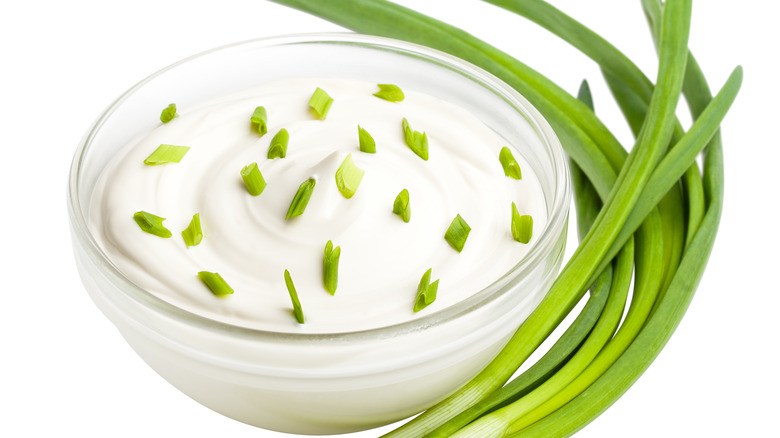Fat Makes All The Difference When It Comes To Sour Cream And Creme Fraiche
When you want to add a creamy, tangy richness to a dish do you reach for a container of sour cream or creme fraiche? More importantly, does it matter which you use?
You might be forgiven for confusing both of these lightly fermented cream products. Both are white, thick, and noted for their sour flavor notes. While they do have plenty of similarities, the two can't always be used interchangeably, and the key to this is their fat content.
Sour cream and creme fraiche are both made with a process called Lacto-fermentation. That means that both of these products are made thanks to the work of bacteria that feed on the sugar lactose. This is heavily present in cream which serves as the starting ingredient of both of these foods. Sour cream and creme fraiche are both made with bacteria cultures that feed on the lactose and produce the lactic acid that gives them their signature flavors. The main difference between them is their fat content.
Different fat content
The fat content of sour cream (unless you opt for the reduced-fat option) is typically going to be around 20%. Creme fraiche on the other hand is usually a little bit higher and sits around 30% instead. This might sound like a fact that only concerns someone watching their fat intake, but it actually has a huge influence on how these two creamy ingredients can be used.
Because sour cream has such a low-fat content, it is best used in cold dishes or as a final topping or garnish on a hot dish. Using sour cream to thicken a stew or soup can be done, but you'll need to be careful. This is because sour cream will curdle when it's raised to a high enough temperature. If you want to use it as a thickener, it's best to do it after your dish has been removed from the heat to reduce the chances of it curdling.
Creme fraiche is able to hold up to higher heat because it has a higher fat content, and lower protein content than sour cream typically. That means it can withstand higher heat without curdling and gives it a boosted versatility when compared to sour cream.
Other differences
The most obvious difference between sour cream and creme fraiche is their taste. Its higher fat content also gives creme fraiche a slightly more creamy flavor. This makes it taste less sour than the appropriately named sour cream, and lets other notes like a subtle nuttiness come through as well. Sour cream is far more tangy and sour thanks to its lower fat content, and higher acidity which makes it more similar in character to Greek yogurt.
That heightened acidity also makes sour cream a useful ingredient in cakes and other baked goods. The acidity deters gluten formation in bread and leaves baked goods tasting moist and tender instead of chewy.
Creme fraiche may often be a better choice for desserts, however. This is because it has a more naturally neutral flavor to it. Sour cream's acidity may come off as savory, but the more natural tang of creme fraiche makes it easily sweetened, and helps it pair well with dishes like chocolate mousse.


